► CAR lives with Seat’s crossover
► Ours is a sporty FR TSI
► Check out our monthly reports
Month 6 living with the Seat Arona: the end of our long-term test
Here’s a question people often ask about the Arona, except they’re not asking what I think they’re asking. ‘What’ll it do, mister?’ these days refers to fuel consumption, and even on one occasion its CO2 figure (darn – caught me out – I had to check), but never the Arona’s top speed. Which is a shame, because I had an accurate and rather surprising answer ready to go: 127mph.
Accurate because Seat wouldn’t make something like that up; not accurate in the sense of it being something I measured for myself. And surprising because it sounds quite high for what I think of as a cheerfully versatile compact family car.
Every so often I would find myself in what you might think of as a suitable location for finding out, but it never happened (although some generally more spirited driving in my final days with the Arona did play merry hell with the fuel consumption). On my penultimate day in the Arona I had to attend a speed awareness course, and briefly thought it would be hilarious to hit 127mph on my way there. But no. Aside from it being daft and indeed illegal, it’s actually deep in the DNA of the FR 1.5 TSI Evo that you don’t use it for top-speed runs on the A43.
How so? It’s geared quite low. The engine is on the revvy side. And it’s not particularly quiet. So what happens, again and again, is that you’re smartly away from the traffic lights and then, without really thinking about it, you back off when you’ve hit a cruising speed that’s not very different from most other people’s. The engine starts to feel strained, the cabin noise level increases just that bit, and you don’t have the impression that there’s much left in reserve. So you briefly pop into the 90s but then ease back into the 80s and all thoughts of 127mph fade into nothing.
Browse Seat Aronas for sale

And you are now part of the herd, one among many. You’re in a crossover, and crossovers are about safety and comfort and headroom and luggage and style before they’re about performance. Accept your destiny and count your blessings – of which there are many, as the Arona is a good thing.
It handles well, albeit not as well as its slightly lower, lighter equivalent, the Ibiza. Its cabin is light and airy, and there are some lovely details. For instance, the elastic straps on the sides of the boot, making it much easier to stop your bags sliding around. Another (less practical) example: when you turn the central infotainment screen off and you’re left with just a digital representation of an analogue clock with two hands, the seconds are shown by the circumference of the dial thickening in one-second increments. It’s Zen-like in its calming, contemplative effect.
As well as these and other neat details, there’s something fundamentally right about the shapes and proportions of the Arona. It catches the eye and makes people smile. My postman, for instance. He likes cars, and had been wondering about an Ibiza. He likes driving, but he’s also conscious of the needs of his elderly mother, who appreciates the ease of access afforded by a crossover’s higher seats and roof. So now he’s not thinking about an Ibiza, he’s thinking about an Arona.
Browse all our Seat reviews
Other things that people never ask about the Arona
- What does FR stand for?
- What’s it like off-road?
- Doesn’t it make you a bit sad that Seat used to make amazing yellow and purple hatchbacks, and briefly looked like the rising force in world rallying, and now they make near-interchangeable VW Group fake-4x4s?
- What does Arona mean?
By Colin Overland
Count the cost: Seat Arona depreciation
Cost new £21,270
Private sale price £17,690
Part-exchange price £16,845
Cost per mile 11p
Cost per mile including depreciation 77.3p
Month 5 of our Seat Arona long-term test review: just an Ibiza on stilts? Or is this the modern-day Yeti?
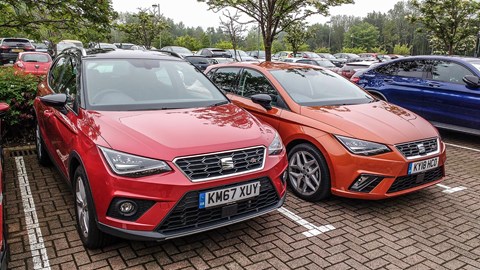
We need to talk about the Skoda Yeti a bit more. In the June issue of CAR magazine, Ben Barry opined in the Icon Buyer feature that it’s a ‘loveable workhorse’, while last month Ben Miller took to the pulpit to praise its ‘original, distinctive’ design. It’s a keeper.
More precisely, for the owners it’s a keeper. Skoda, however, seems less emotionally attached, and has replaced the refreshingly individual Yeti with a couple of very generic SUVs, and there’s a third due next year. People keep asking me if the Arona is something to do with the Yeti.
They know it’s the wrong badge and a different face, but there’s something about the Seat’s posture and proportions that evokes the Yeti. She ain’t no Skoda – but we can dream…

I wish there was some substance to this, but the plain truth is that it’s a taller Ibiza – no more, no less. The ‘taller’ bit is not all about fashion over function, even though it’s easy to dismiss crossovers in that way.
You get that useful extra space for passengers’ heads and for luggage, so when you try to squeeze a load of hedge cuttings and broken bicycles into the back, the Seat generally obliges. And the Ibiza is quite a dull car these days, whereas the Arona – or at least this Arona – is quite perky and engaging.
I haven’t done many miles this month, and they’ve mostly been in town for short shopping trips. The fuel consumption has suffered, but not by much. But the Arona remains obliging, easygoing transport, and a little bit more. But not that much more.
By Colin Overland
Logbook: Seat Arona FR 1.5 TSI Evo
Price £21,270
As tested £21,270
Engine 1498cc 16v turbocharged 4-cyl, 148bhp @ 5000rpm, 184lb ft @ 1500rpm
Transmission 6-speed manual, front-wheel drive
Performance 8.3sec 0-62mph, 127mph, 115g/km CO2
Miles this month 225
Total 7763
Our mpg 37.9
Official mpg 55.4
Fuel this month £35.33
Extra costs None
Month 4 of our Seat Arona long-term test review: a brief tour of the bits we like
One for a golden oldie…
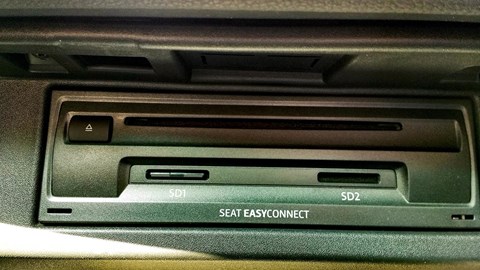
The FR comes with some things I wouldn’t particularly ask for, but which are actually pretty good – smartphone integration, MirrorLink etc. All very modern. But, to be honest, I’m more pleased by there being a CD/DVD player in the glovebox, barely mentioned in the Seat brochure. I’ve got a house full of CDs, and often find I’d rather play a CD than plug in an MP3 player.
Bulb Fiction
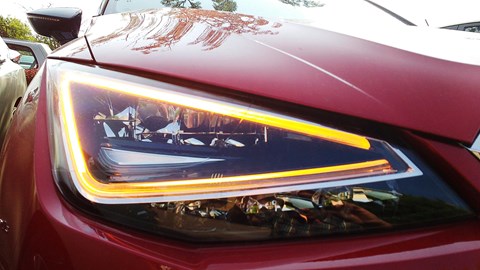
It was only when I crossed paths with another Arona that I realised what’s going on with the front indicators: they are the daytime running lights. I’m easily offended by tricksy light foolishness, but these are great, partly because they make good use of space but mostly because they look like John Travolta’s hand gestures when he’s dancing with Uma Thurman in Pulp Fiction.
Joining the diesel deserters
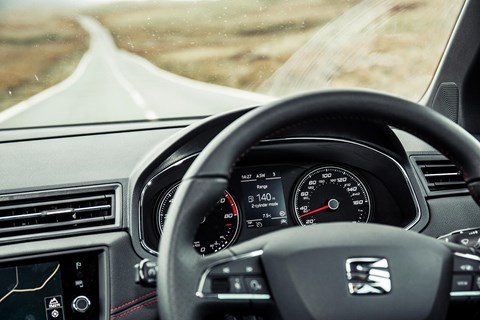
Oh how foolish Dieselgate looks when it turns out the VW Group is capable of making its petrol engines this clean, efficient and enjoyable. Active two-cylinder running doubtless helps, but the pleasingly high mpg figure must mostly be down to the fundamentals of fuelling, combustion, friction, gearing and aero being spot on.
A splash of chrome
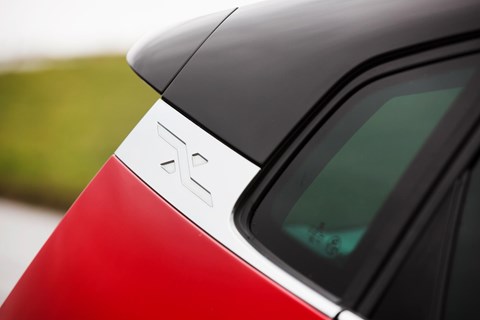
This pillar makes all the difference to the looks of the Arona, especially when combined with the contrasting roof (a no-cost option). It’s not a detail unique to the Arona – variations appear on the Volvo X40, Audi Q2 and the Renault Captur, to name some of the most effective – but it’s still unusual enough to make a difference.
By Colin Overland
Logbook: Seat Arona FR 1.5 TSI Evo
Price £21,270
As tested £21,270
Engine 1498cc 16v turbo 4-cyl, 148bhp @ 5000rpm, 184lb ft @ 1500rpm
Transmission 6-speed manual, front-wheel drive
Performance 8.3sec 0-62mph, 127mph, 115g/km CO2
Miles this month 506
Total 7032
Our mpg 40.2
Official mpg 55.4
Fuel this month £75
Extra costs None
Month 2 living with a Seat Arona: the practicalities of daily life
Cruise control is often a waste of space but the Arona’s system is so simple and neat that I’ll give it a pass. And, the other day, I actually used it. Everything is controlled by two tiny switches on the indicator stalk. It doesn’t do anything clever; it just holds your speed steady. If you think you’re going to crash or get in someone’s way, you over-ride it.
Why use it at all, after months of shunning it? Because I was driving back to the Midlands after a long, sweaty day’s work at Goodwood, and thought using cruise control might de-stress me a bit. It did, helped by the very effective climate control.
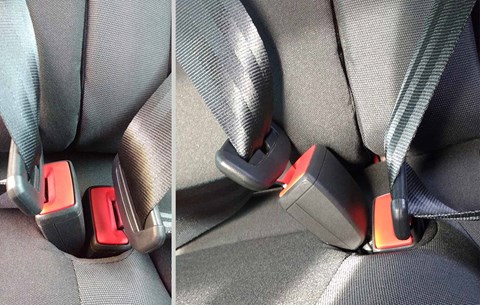
Meanwhile, there’s been a VW/Seat recall on Polos, Ibizas and Aronas, caused by concern that the left rear seatbelt could in certain circumstances become undone if all three rear seats were occupied (which hadn’t happened on the two occasions when I’ve had all three rear seats occupied).
The problem is that the buckle for the centre seat is just above the buckle for the left seat, and can press down on it during cornering (see above left). The fix has involved a slight repositioning (see above right) that stops this happening.
By Colin Overland
Month 1 of our Seat Arona long-term test review: the introduction
Some of the most pleasing things about these early days with the Seat Arona are things that aren’t there. Or, put more positively, there’s a wonderful absence of clutter and filler.
No central armrest or oddments bin. Why not? Because there’s a real handbrake – always a good thing. No keyless entry, so instead there’s a conventional key, which avoids any ‘where’s my key?’ confusion.
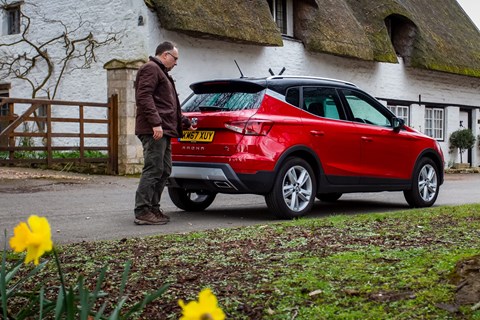
No lane-departure or automatic emergency braking or cruise control. And no electronic assistance for the boot or steering column or seat adjustment. What you get is a good engine and a decent chassis in a compact but reasonably roomy and stylish package. Everything is there for a very clear reason, that reason being to let you get on with driving the car and using it to ease your way through the daily grind.
There are no options fitted to the car, because there aren’t any available. Seat’s current philosophy is that the spec levels are distinct and well defined, and once a potential
customer has plumped for an engine and a colour, they’ll quickly spot which spec level suits their preferences. Job done.
I’m not sure it’s quite as simple as Seat says it is. There are six trim levels (and Seat did that vogueish thing of also having a special early-buyer spec level called First Edition), which come in three pairs. The most basic is SE, but there’s also the slightly higher SE Technology (which brings you upgraded infotainment). At the top there’s the techy Xcellence and techier Xcellence Lux. In the middle there’s my car, the FR, but also the FR Sport (with 18-inch rather than 17-inch wheels, alacantara not cloth upholstery and more sophisticated suspension; that lot adds £770 to the price). FR has sporty seats, black interior detailing, four driving modes, climate control, chrome roof rails plus different grille and rear bumper designs.
My engine, the 1.5 turbocharged petrol four, is only available with the FR and FR Sport. In the UK, all Aronas are front-drive and five-door only, and come with metallic paint. There are two smaller petrols and a couple of diesels. Some models are available with seven-speed auto. I suspect I’ve got the best of the bunch.
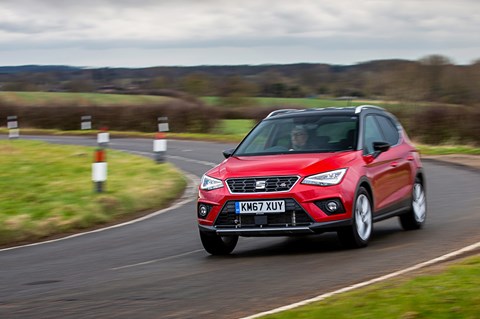
The cornering does suffer from the Arona’s extra height over the smaller, lighter Ibiza, but overall it’s good – certainly more fun than the larger Ateca. You need to engage with it – keep the engine spinning and you’ll find plenty of power without too great a thirst for fuel. It gets a bit loud when you rev it hard, but is generally refined and comfortable.
My fiddling with the modes (Eco, Comfort, Sport, Individual) may make a bit of difference to the economy, but bigger benefits come from smooth driving. You know you’re being smooth because you get a message flashed up saying that two of the four cylinders have been deactivated, and you’re cruising along on minimal fuel. Without the message you really wouldn’t know half the engine has its feet up on the desk.
By Colin Overland
Logbook: Seat Arona FR 1.5 TSI EVO
Engine 1498cc 16v turbocharged 4-cyl, 148bhp @ 5000rpm, 184lb ft @ 1500rpm
Transmission 6-speed manual, front-wheel drive
Stats 8.3sec 0-62mph, 127mph, 115g/km CO2
Price £21,270
As tested £21,270
Miles this month 1382
Total miles 2364
Our mpg 38.2
Official mpg 55.4
Fuel this month £199.23
Extra costs None
Check out our Seat reviews here